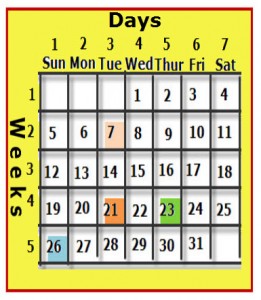Things that repeat according to a pattern are said to be periodic.
On a calendar, days are in numerical order in columns (up and down).
Each Column (vertical group) is for the same day of the week. Every seventh day falls on the same day. Thus, the dates for the same day of the week are in columns.
On a calendar, weeks are rows (horizontal).
Each Row (horizontal group) is for the same period of time, 7 days or 1 week.
Activity
Using the calendar shown, answer these questions:
1. What do the dates 5, 12, 19, and 26 have in common?
Answer:
The dates are all on the same day of the week, which is Sunday.
The dates are in the same column or group.
If the columns were numbered, starting at Sunday, then the dates are all in group 1.
2. What do the dates, 26, 27, 28, 29, 30 and 31 have in common?
Answer:
The dates are all in the same week.
The dates are all in the same period.
If the weeks were numbered, the dates would be in the 5th period (5th week).

3. The period and group numbers on a calendar can be used as coordinates, much like map coordinates or math coordinates. When writing coordinates, the row number or x-axis value is written first followed by the column number or y-axis value.
For example, using the calendar shown, coordinate (2, 3) is read as, week 2, and day 3 (Tuesday).
The date for coordinate (2, 3) is 7. In the diagram 7 is highlighted in pink.
List the coordinates for these dates, 21, 23, and 26.
Answers:
The coordinates are:
21 is (4,3); 23 is (4,5); 26 is (5,1)
Big Book of Science Experiments
A book of fun informative experiments about astronomy, biology, chemistry, earth science, and physics.
(Paid Link)

